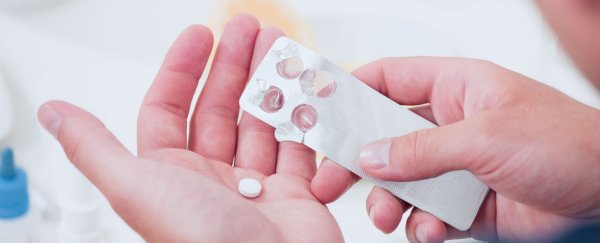A new pill developed by researchers in the US successfully stops the development of type 1 diabetes in mice, and if shown to work similarly in humans, could be used to prevent the onset of the disease as soon as early symptoms appear.
Type 1 diabetes is an autoimmune disease that's usually diagnosed during childhood and adolescence. It develops when the body's own immune cells start attacking the insulin-producing beta cells in the pancreas, which forces patients to take regular insulin injections to replace the blocked supply. And while we know how this process plays out, scientists aren't entirely sure what triggers it.
The pancreas is littered with tiny cell clusters called islets that produce a range of hormones, and researchers from Stanford University in the US decided to investigate why in the onset of diabetes, the body's immune system only ever attacks the insulin-producing ones.
"In type 1 diabetes, only the beta cells get destroyed. Why this happens is poorly understood," one of the team, Paul Bollyky, said in a press release. "But it's known that during the disorder's early, pre-symptomatic stage, pancreatic islets become inflamed - that is, they get infiltrated by immune cells."
By the time a person starts showing the typical symptoms of type 1 diabetes, 90 percent of their pancreatic beta cells will have been killed off. "Neither the cause of immune cells' initial infiltration of pancreatic islets nor the trigger for their transition from mere passive presence to active aggression is yet understood," says Bollyky.
The pancreas is incredibly difficult to study, and the only real option scientists have to observe what's going on in there at a cellular level is to examine ones that have been donated after death. Bollyky and his colleagues were lucky enough to work with pancreases that had been donated to the Juvenile Diabetes Research Foundation by type 1 diabetes patients who had died right after being diagnosed. This allowed them to see what goes on in the early stages of development.
The team discovered that these pancreases all had a severe buildup of hyaluronic acid near the beta cells - something that did not show up in patients who'd lived with the disease for decades. This in itself was not surprising, as patients who've had diabetes for years would have lost their beta cells a long time ago, but this is the first time that scientists had been able to link the progression of type 1 diabetes to changes in the extracellular matrix that comprises our tissues.
The researchers suspect that the hyaluronic acid buildup is helping the malfunctioning immune system wreak even more havoc on the pancreas, Loren Grush reports for The Verge. "Hyaluronic acid is instrumental in causing sites to swell; it soaks up water and increases fluid buildup," she says. "It also makes inflammation worse by suppressing the body's regulatory T cells, which help to keep the immune system in check."
The next logical step was to figure out how to fight this acid buildup so the T cells could continue doing their job. "We wondered what would happen if we prevented that buildup," Bollyky said in a press release. "And we knew a drug that does that."
Called Hymecromone - or 4-methylumbelliferone (4-MU) - the drug is inexpensive, can be taken orally, and has been prescribed in many European and Asian countries for painful, gallstone-associated spasms for years. Over four decades of use, it's earned what Bollyky describes as an "extremely boring safety profile", and has been approved for use by children in Europe.
The researchers tested it out on mice that had been genetically engineered to develop type 1 diabetes, and found that by blocking the acid buildup, the regulatory T cells were free to show up and mitigate the malfunctioning immune response. The beta cells remained intact in the mice that took the drug, and were wiped out in the mice that didn't.
"The invading army doesn't go anywhere, but all of a sudden it becomes respectful," Bollyky told The Verge. "It's respectful inflammation that's not destroying your beta cells anymore."
The results have been published in the Journal of Clinical Investigation.
The next step - and it's a big, huge one - is to see if the same reaction can be brought out in humans with developing type 1 diabetes, and they've received funding from Stanford to figure it out. If they can replicate the results in a clinical setting, it could mean that doctors could screen for at-risk patients early on, and then prescribe a pill that would stave off the development of the disease. "Instead of taking insulin for the rest of your life, it'd just be a pill, and you wouldn't get diabetes," Bollyky said.
